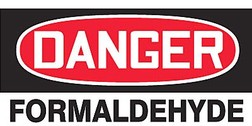
Formaldehyde is a colorless, pungent-smelling chemical widely used in industries that manufacture building materials and numerous household products. Thus, it may be present in substantial concentrations in indoor environments.
Where indoors may formaldehyde be found?
- pressed-wood products (such as hardwood plywood wall paneling, particle board and fiberboard), and furniture made with these pressed-wood products. Mobile homes are especially at risk for indoor formaldehyde pollution because of their abundance of composite wood in construction, and relatively compact interior space;
- carpet backing and urea-formaldehyde foam insulation (UFFI). In the 1970s, many homes were insulated with UFFI as an energy-conservation measure before it was discovered that UFFI contained dangerously high levels of formaldehyde. Fortunately, formaldehyde emissions in this product decline over time, so older houses with UFFI are unlikely to have high levels of formaldehyde now. This insulation is not very common in modern housing;
- tobacco smoke;
- durable-press drapes and other textiles;
- un-vented, fuel-burning appliances, such gas stoves and kerosene space heaters; and
- glues.
Is it dangerous?
Four years after concern arose over high levels of formaldehyde found in some FEMA trailers, there is still a great deal of confusion regarding permissible levels of airborne formaldehyde in indoor environments.
Formaldehyde is known to cause the following conditions:
- watery eyes;
- burning sensations in the eyes and throat;
- nausea;
- wheezing, coughing and difficulty breathing;
- asthma attacks;
- fatigue;
- skin rash;
- severe allergic reactions; and
- cancer. Uncertainty remains as to how to compare measured air concentrations of formaldehyde to cancer incidence. No definitive "high risk" level can be drawn because many other factors besides formaldehyde exposure play a role in the development of cancer. In general, however, the lower the level and shorter the duration of exposure, the less risk of cancer and other health effects there are.
Steps to Reduce Exposure
- Use exterior-grade pressed-wood products (lower-emitting, because they contain phenol resins, not urea resins).
- Use air conditioning and dehumidifiers to maintain a moderate temperature and reduce humidity levels.
- Increase ventilation, particularly after bringing new sources of formaldehyde indoors.
- Seal non-laminated surfaces of products containing formaldehyde with paints, varnish or polyurethane-like materials.
For questions concerning property inspections, or to schedule your property inspection, contact Bennett Property Inspection today at (813) 260-9920.



 RSS Feed
RSS Feed

